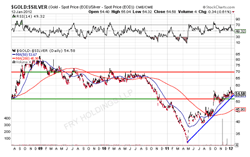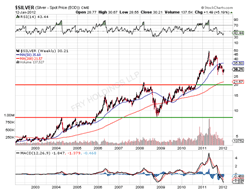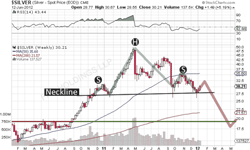|
|||
Short-Term Market AnalysisAndrew Fry Currency Supply The broadest measure of currency supply in the United States was M3, until the Federal Reserve decided in 2006 that it was too expensive to produce thus discontinuing the series. Many private economists including John Williams (from ShadowStats.com) and Bart (from nowandfutures.com) have reproduced the series (as see in the chart below). The M3 currency supply is an indicator of future “price inflation” or “price deflation.” In July of 2009, M3 began contracting as individuals/institutions began saving and paying down debt. The following chart indicates that M3 began contracting in May 2009 until June of 2010, even as the Federal Reserve began expanding the monetary base (high powered money). (Click on images to enlarge) All currency (US Dollars) is created by debt, when a loan agreement is signed, the currency did not previously exist. It is literally created out of thin air the second the loan agreement is signed. The Federal Reserve distributed a paper called Modern Money Mechanics, which describes the money creation process in a fractional reserve system. The paper describes the process of money creation: “Of course, they [banks] do not really pay out loans from the money they receive as deposits. If they did this, no additional money would be created. What they do when they make loans is to accept promissory notes [contracts] in exchange for credits to the borrowers' transaction accounts. … Reserves are unchanged by the loan transactions. But the deposit credits [currency] constitute new additions to the total deposits of the banking system.” Since all currency is created from debt, the opposite is true when debt is paid back - currency is literally “destroyed,” therefore, as investors begin to deleverage by paying down their debts, they are in effect reducing the total currency supply (M3). The Federal Reserve has responded to this private sector deleveraging by expanding the monetary base by purchasing US Treasuries (Quantitative Easing) and other paper assets. To get a full picture of the deflationary market forces, the following chart represents M3 minus the Monetary Base: The monetary base (MB) is directly controlled by the Federal Reserve; therefore, when the MB is removed from the currency supply a better picture of the private sector’s willingness to reduce debt is provided. The currency supply has declined since 2009, causing dollars to “gain value.” Therefore this should apply downward pressure on the prices of commodities and stocks in the near future. Modern Money Mechanics explains how money derives its value: “What, then, makes these instruments - checks, paper money, and coins - acceptable at face value in payment of all debts and for other monetary uses? Mainly, it is the confidence people have that they will be able to exchange such money for other financial assets and for real goods and services whenever they choose to do so. Money, like anything else, derives its value from its scarcity in relation to its usefulness.” Since “usefulness” and scarcity are the primary components of value, a decrease in the supply should inversely affect the currency’s purchasing power. Contractions or expansions of the currency supply do not affect all prices uniformly or immediately. Therefore, it can take the market years to determine the correct price level of a given commodity or asset. Silver Prices Silver has two major components to its value; monetary and industrial. During a deflationary period, economic activity will decline thereby putting downward pressure on the industrial demand for silver. Additionally, as the scarcity of dollars increases and credit becomes less prevalent, many investors who were inflation hawks, will rapidly become concerned with a “deflationary outcome.” Since many investors hold silver as a hedge against a devaluing currency, the selling of the white metal will continue as fears of deflation run rampant. First let’s look at the Gold to Silver ratio, which is a good indicator of the public’s concern about inflationary or deflationary forces. In times of currency devaluation, the ratio shrinks and times of currency appreciation, the ratio widens. The next chart shows silver’s 10-year bull market, its parabolics and subsequent corrections. The twenty dollar level, which once acted as strong resistance, is now providing significant support. The two year silver chart is the most telling of short term price action. A clear head and shoulder pattern emerges, suggesting significant price declines within the next several months. “Head and shoulders is a [technical] reversal pattern that, when formed, signals the security is likely to move against the previous trend... The head-and-shoulders top is a signal that a security's price is set to fall, once the pattern is complete, and is usually formed at the peak of an upward trend.” Within the next month or two silver should see a rally to the $33 area and then a prolonged decline if the neckline of the head and shoulders pattern is breached. If the neckline is not broken by April or the resistance level of $37 is breached, this scenario may not play out. ### Jan 17, 2012 Disclaimer: The materials and information in this article are not, and should not, be interpreted as an offer to buy or sell any of the securities named in these materials. We strongly recommend that you consult with a professional broker or financial planner before you buy or sell any stock or security. We believe the information in this publication to be true but assume no responsibility for any incorrect information. This is not a solicitation to buy or sell any security. Past performance is not necessarily an indication of future performance. Both investing and trading have potential rewards, as well as large potential risks. Trading or investing may not be suitable for all readers. The reader assumes the entire cost and risk of any trading or investing they choose to undertake. For Contact/Comments/Disagreements email Andrew Fry. |





